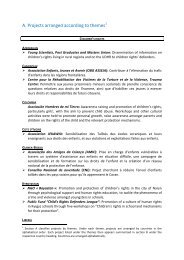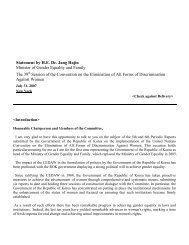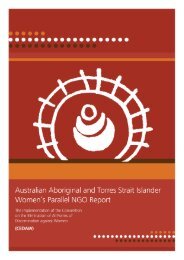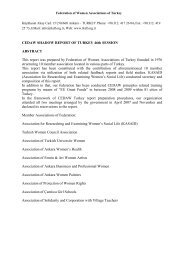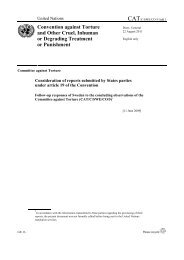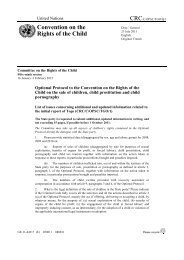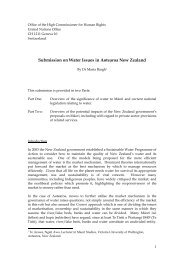National Research on Domestic Violence Against Women in
National Research on Domestic Violence Against Women in
National Research on Domestic Violence Against Women in
You also want an ePaper? Increase the reach of your titles
YUMPU automatically turns print PDFs into web optimized ePapers that Google loves.
the percentage of those resp<strong>on</strong>dents who c<strong>on</strong>firm thatthey need husbands’ permissi<strong>on</strong> before gett<strong>in</strong>g medicalhelp decreases.A higher percentage of rural residents and resp<strong>on</strong>dentswho do not earn m<strong>on</strong>ey by themselves also admit thatthey need their husband’s permissi<strong>on</strong> before go<strong>in</strong>g to adoctor compared to representatives of other respectivegroups.Of all the women <strong>in</strong>terviewed, some say that every reas<strong>on</strong><strong>in</strong>dicated <strong>in</strong> the questi<strong>on</strong>naire justifies a man beat<strong>in</strong>ghis wife. The largest number of resp<strong>on</strong>dents (<strong>on</strong>ethird) th<strong>in</strong>ks that <strong>in</strong>sult<strong>in</strong>g woman physically is justifiedif a husband “f<strong>in</strong>ds out that she has been unfaithful”; acerta<strong>in</strong> part of the <strong>in</strong>terviewees th<strong>in</strong>k that this behaviouris justified if a husband is jealous (<strong>on</strong>e <strong>in</strong> 15) or ifhis wife does not obey him (approximately <strong>on</strong>e <strong>in</strong> 18).Compared to representatives of other respective groups,a higher percentage of rural residents, resp<strong>on</strong>dents whohave <strong>in</strong>complete sec<strong>on</strong>dary educati<strong>on</strong> and women whodo not earn m<strong>on</strong>ey by themselves th<strong>in</strong>k that “she doesnot complete her household work to his satisfacti<strong>on</strong>”,“she disobeys him”, “she refuses to have sexual relati<strong>on</strong>swith him”, “she asks him whether he has other girlfriends”,“he suspects that she is unfaithful”, are goodreas<strong>on</strong>s for hitt<strong>in</strong>g a wife.Compare to the representatives of other groups, a farlower percentage of Tbilisi residents, resp<strong>on</strong>dents withhigher educati<strong>on</strong> and those who have <strong>in</strong>dependent <strong>in</strong>cometh<strong>in</strong>k that “if he f<strong>in</strong>ds out that she has been unfaithful”is a good reas<strong>on</strong> for a husband to hit a wife.Of the resp<strong>on</strong>dents who have a husband/partner, <strong>on</strong>e <strong>in</strong>24 says this partner has d<strong>on</strong>e someth<strong>in</strong>g caus<strong>in</strong>g physicalharm to her; an almost identical account was c<strong>on</strong>firmed<strong>in</strong> the groups dist<strong>in</strong>guished after social-demographic <strong>in</strong>dicators.Most <strong>in</strong>terest<strong>in</strong>g here was that all age groupsshowed similar percentages of who have been victimsof physical violence - that is to say that the <strong>in</strong>cidents ofabuse beg<strong>in</strong> from the very first years of the marriageand rema<strong>in</strong> approximately at the same level until theend. In practice this means that the age factor does not<strong>in</strong>fluence whether physical violence will happen or not.Instances of men <strong>in</strong>sult<strong>in</strong>g their wives verbally are quitefrequent. One <strong>in</strong> five of the <strong>in</strong>terviewees say they haveexperienced this. This picture does not change significantlybased <strong>on</strong> social-demographic <strong>in</strong>dicators.One <strong>in</strong> 28 of the <strong>in</strong>terviewees say their husband hascommitted the follow<strong>in</strong>g acts aga<strong>in</strong>st her: public humiliati<strong>on</strong>,verbal threats of divorce or physical violence; <strong>on</strong>e<strong>in</strong> 20 women say her husband has refused to give herm<strong>on</strong>ey; <strong>on</strong>e <strong>in</strong> 25 women say her husband prevents herfrom work<strong>in</strong>g; <strong>on</strong>e <strong>in</strong> 40 women said her husband hadforced her to have sex.Hence we can say that there is a whole spectrum oftypes of violence (physical verbal, f<strong>in</strong>ancial, sexual),which some (sometimes many) women endure; socialdemographic<strong>in</strong>dicators do not usually play an importantrole <strong>in</strong> this regard.Resp<strong>on</strong>dents th<strong>in</strong>k that the ma<strong>in</strong> reas<strong>on</strong>s for differentdiscrim<strong>in</strong>ative behaviours are husband’s drunkennessand material problems (e.g. f<strong>in</strong>ancial problems, unemployment).One of the frequently menti<strong>on</strong>ed answersis “he had no reas<strong>on</strong>”. One <strong>in</strong> six or seven women wasexposed to violence by her husband for “disobedience”or because he suspected she was unfaithful.When it comes to place of residence, <strong>in</strong> the case of Tbilisiresidents two of the five most comm<strong>on</strong>ly cited reas<strong>on</strong>sare related to a relati<strong>on</strong>ship between a man and awoman, whereas with rural resp<strong>on</strong>dents material factorsand housewife’s obligati<strong>on</strong>s are more accentuated(this is borne out by the fact that “if th<strong>in</strong>gs are not tidiedup at home” is seventh <strong>on</strong> the list of reas<strong>on</strong>s). Similarpeculiarities are revealed <strong>in</strong> the group of women with<strong>in</strong>complete sec<strong>on</strong>dary educati<strong>on</strong>.The spectrum of reas<strong>on</strong>s given for men to engage <strong>in</strong> coercivebehaviour was broader than that of restrictive orother discrim<strong>in</strong>atory behaviour. This means that a c<strong>on</strong>siderablenumber of women who are victims of violenceendure it due to several different reas<strong>on</strong>s; the problemof drunkenness is most frequently cited (by over half of<strong>in</strong>terviewees), while the sec<strong>on</strong>d was “no reas<strong>on</strong>”; thisselecti<strong>on</strong> of women tends to highlight reas<strong>on</strong>s relatedto the relati<strong>on</strong>ship between husband and wife (jealousy/ he is sure she is not faithful, she refuses to have sexwith him / due to some problems <strong>in</strong> sexual relati<strong>on</strong>s, shedoes not obey).In their respective groups, Tbilisi and urban residents,women who do not have their own <strong>in</strong>come and womenwith higher educati<strong>on</strong>, were more likely to share theirthoughts <strong>on</strong> the reas<strong>on</strong>s why husbands attack theirwives.NATIONAL RESEARCH ON DOMESTIC VIOLENCE AGAINST WOMEN IN GEORGIA85




